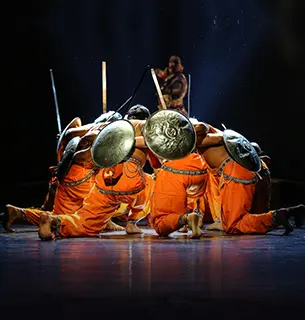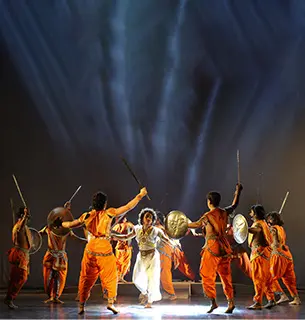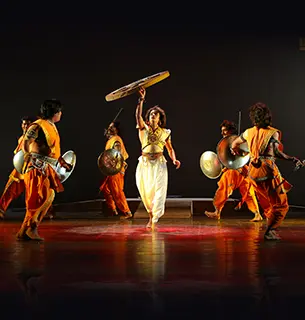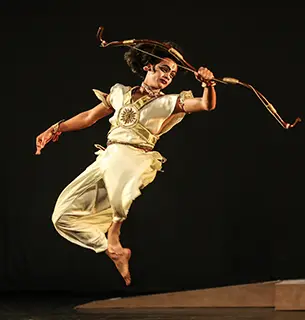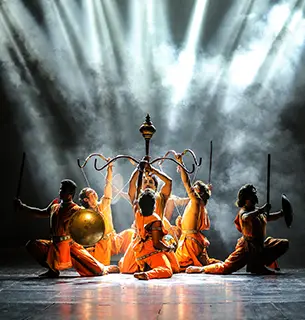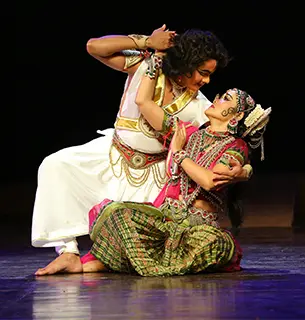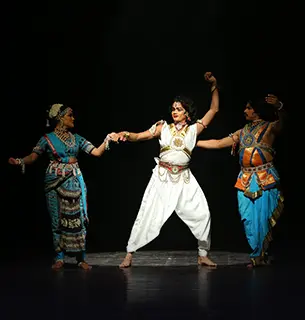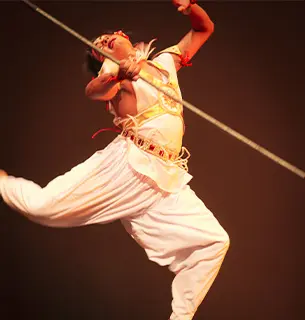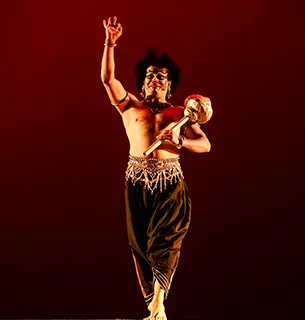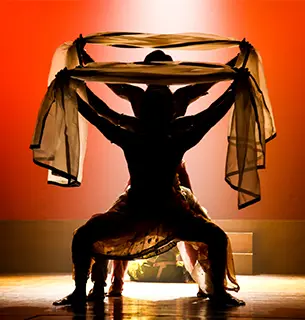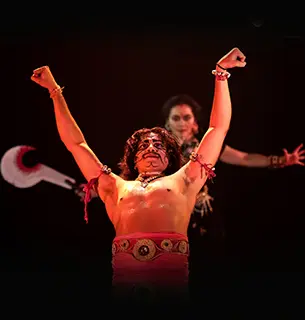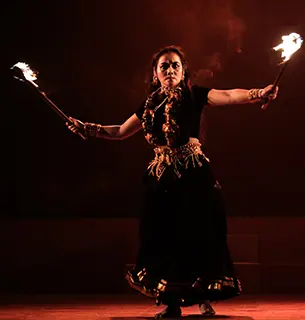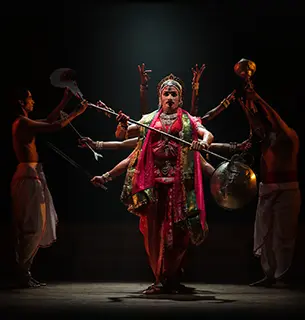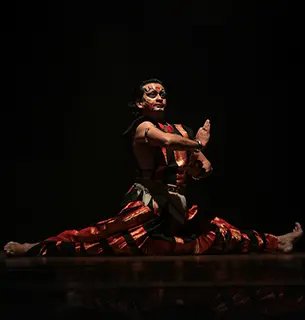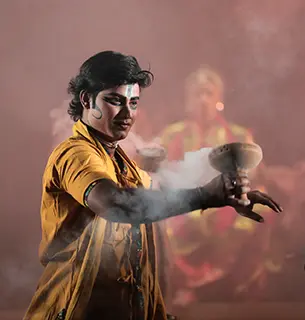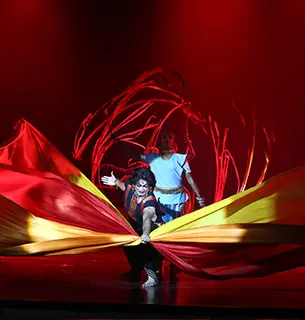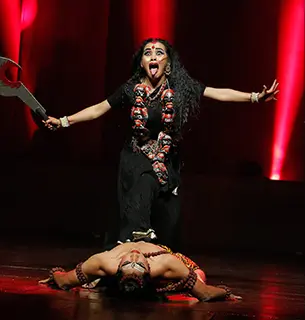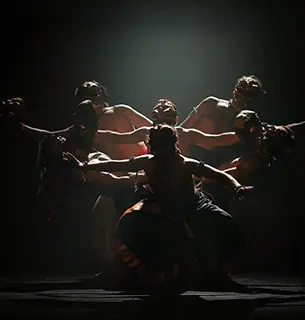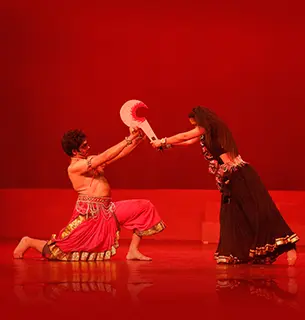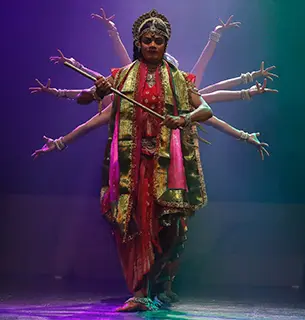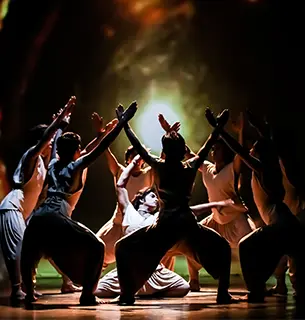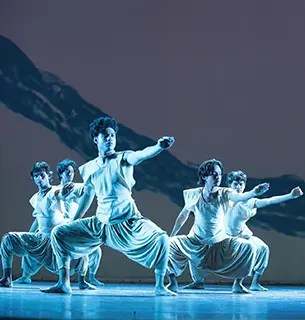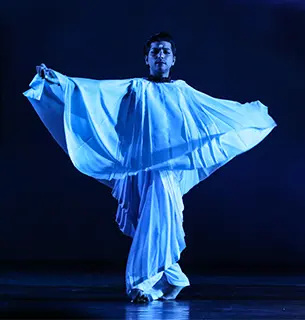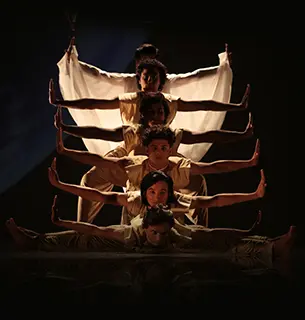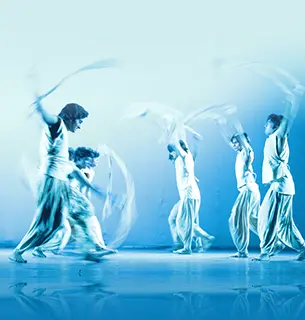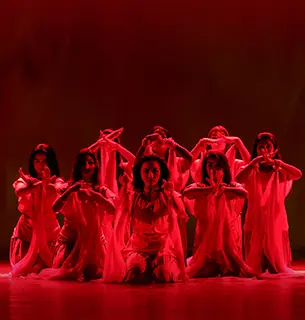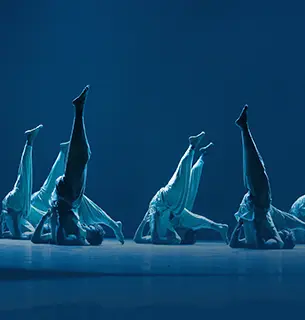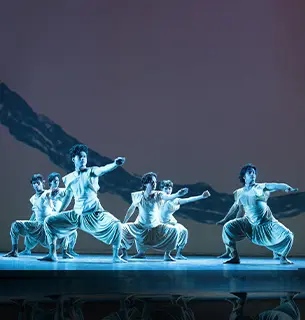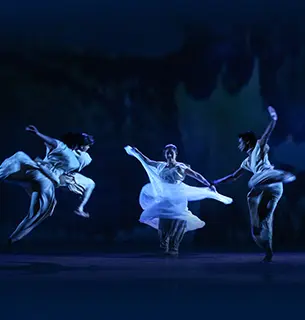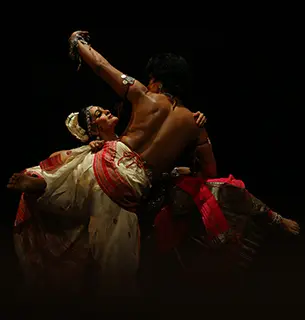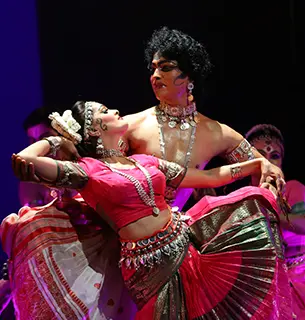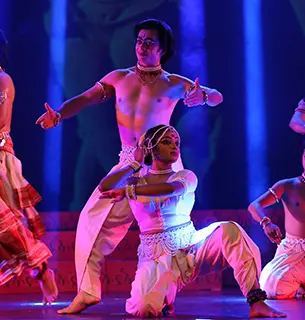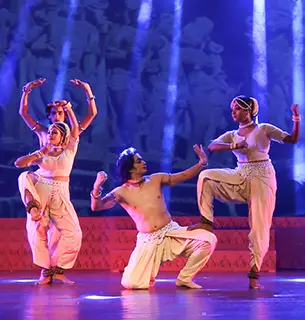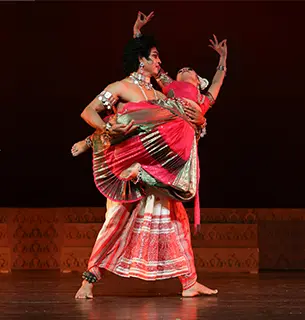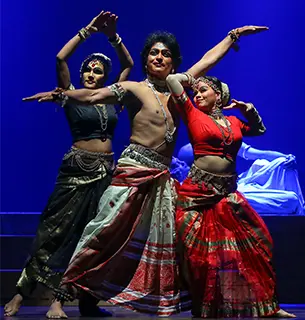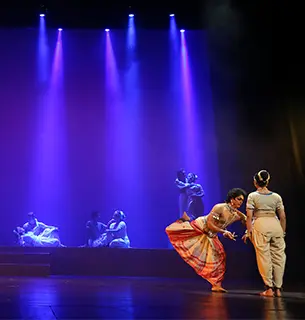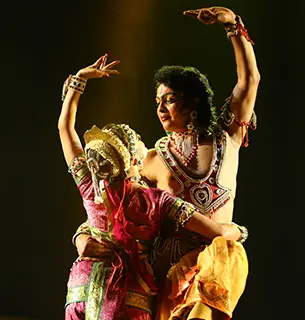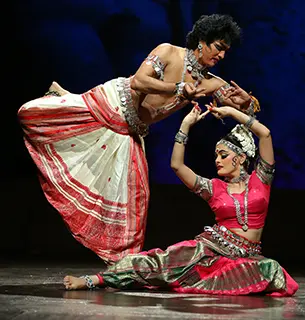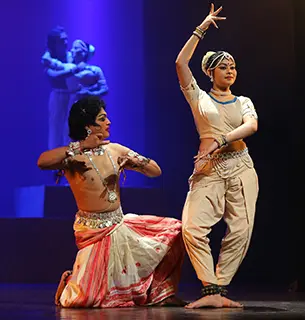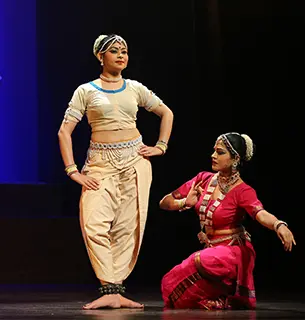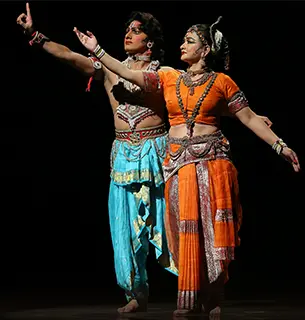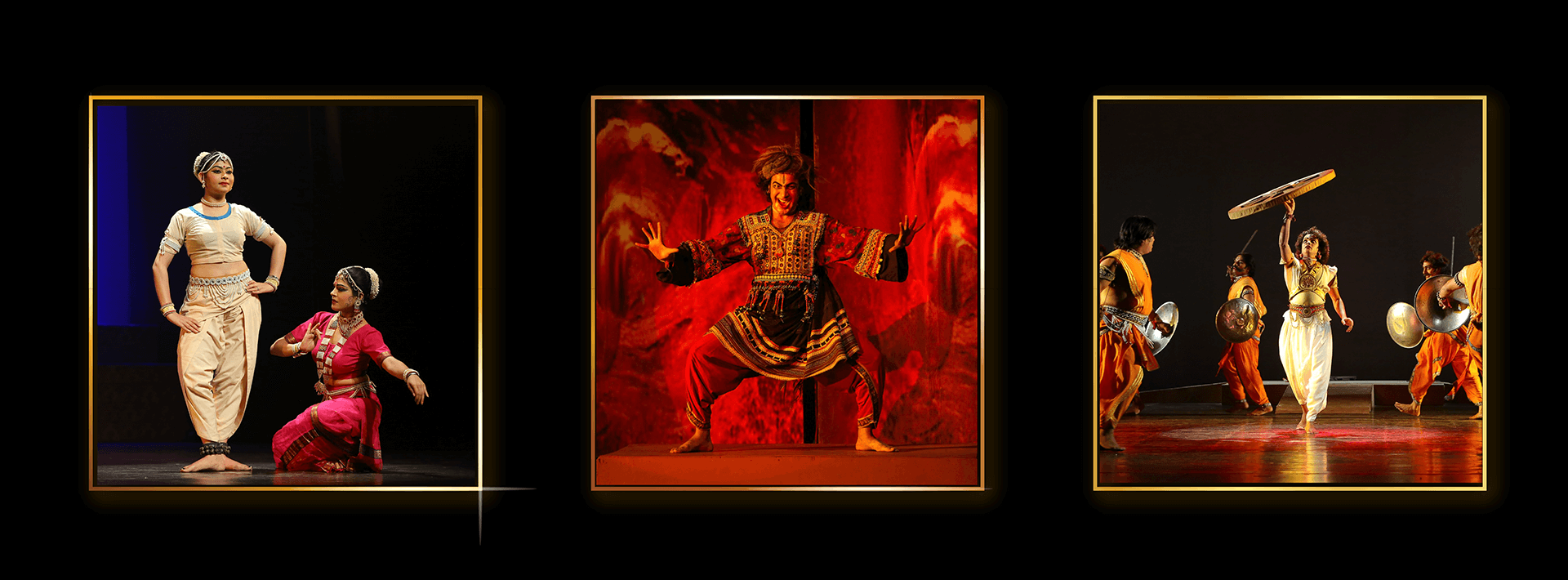
About Popular Productions
During the last six decades, the Kendra has choreographed and staged over 60 productions. It also experimented in productions in contemporary forms and topics. A shortlist of popular dance-dramas produced by the Kendra are Karna, KaalChakra, Durga, Chakravyuha, Khajuraho, Kathak Group Work, Bharatanatyam Group Work, and Mayurbhanj Chhau Group Work.
The worship of Durga is most commonly associated with the vanquishing of the demon Mahishasur. Mahishasur was awarded the blessing of being invincible to all his opponents but was destined to be killed at the hands of a woman. In a fight, he overcame the gods and assumed their posts. The gods gathered and discussed the disaster. The scenario necessitated a lady, a great fighter with abilities – The Goddess – capable of eluding the demon.
They presented their fire, power, and weapons to Durga, who refused to be humble or subordinate. She would not give in to them; instead, she would steal their fire and might. Because Durga was not protected by a male god, Mahishasur imagined she would be powerless, as women are typically represented.
However, the Goddess laughs. She enjoys both war and difficulties. Kali consumes the demon’s blood before a drop falls to the earth. When Raktabeej strikes her, Kali shoots back, her bloodshot eyes rolling up in drunken excitement. The demon collapses and dies, and the Goddess bursts into a victory dance, drunk on blood and success. She is unstoppable until Shiva himself falls in the path of her dance, and her intoxication is broken as she unwittingly steps on Him.
Raktabeej, who represents the ego, now takes a back seat. A feeling of Self, with its richness of substance and texture, is now prevalent. This metamorphosis was created by Kali, who is Durga in her magnificent, dynamic, and ferocious position.
Durga and Kali are not relics of a bygone past but are just as relevant now. Every day, one reads of crimes against women. When the Gods bestow boons, the recipients become victims of the boons, and it is at this point that they call ‘Shree Shakti’ or the ‘Feminine Power’, to exorcise demons in society.
KaalChakra is a state of mind which forms an integral part of the Indian psyche. It plunges into and emerges from the cycle of human birth and death.
KaalChakra commences with the ‘Hiranyagarbh’ or the Golden Egg – a state where nothing was and everything is. The Hiranyagarbh is covered with filaments of five elements – ether, wind, fire, water, and Earth. Brahman, the soul of the Hiranyagarbh, seeks to manifest itself in the form of the Atman, from a state of non-being to that of being. The Atman seeks communion with the body. It perforates rarified ether, wind, fire, and water — finally descending upon the placid Earth and entering the human body. Birth thus takes place with the union of body and soul. The human body is charged with energy. Initially, the Atman is in harmony with the five senses of sight, sound, touch, smell, and taste. Soon, the senses take control and the Atman becomes subservient to them. Discord and conflict set in between the two. The fettered Atman is fatigued and without hope. Just as a well is drained of water, so is the Atman drained of its own being.
A desire for liberation gradually awakens in the Atman. It begins its arduous and formidable journey towards its goal of emancipation from the senses. It pierces through five sheaths in descending order of density. It survives earthquakes, tumultuous waters, raging fires, stormy winds, and polluted ether to realise the eternal truth that —
Beyond the objects is the mind
Beyond the mind are the senses
Beyond the senses is the intellect
Beyond the intellect is its own identity
Beyond its own identity is the non-manifest
Beyond the non-manifest is the spirit
Beyond the spirit there is nothing
And where there is nothing
There is absolute blissful consciousness.
— Katha Upanishad
The Atman thus makes a full KaalChakra of the cycle of birth and death, achieving Moksha by merging into the supreme light of consciousness.
Since the year 1977, Shriram Bharatiya Kala Kendra has been attempting experimental productions on the Mayurbhanj Chhau technique. To date, we have staged three ballets — Jagadev (a folk-tale from Bihar), Konark (a myth surrounding the construction of the sun temple of Konark) and Kaling Vijay (a play written by Shri Chattur Bhuj on Ashok Maurya).
Khajuraho is another venture in the same vein based on the Mayurbhanj Chhau technique. It is an adaptation of a play by Shankar Shesh, depicting the origin of the temples of Khajuraho and the reason for their exposure to the art of making love. In this presentation, we have attempted to capture and portray the sentiment with which the sculpting of these temples was undertaken.
In Khajuraho, Guru K. C. Naik placed greater emphasis on the Lasya aspect of the male and female movement, with glimpses of the Tandava facet, wherever the storyline requires it. In many instances, Abhinaya (facial expression), Mudras (hand gestures) and mime have been woven into the dance sequences to enhance the mood, in the hope that the desired sentiment is depicted lucidly. The innovative musical score, composed and conducted by Sh. Barun Gupta, comprises an orchestra of numerous traditional percussion and stringed instruments played solo or in combination with the electric organ/synthesizer. The music of the Sitar, the Sarod, the Flute, the Chhau Dhol, the Tablas, the Tabla Tarang, and the Dholak is synchronised with mood notes from the synthesizer, to offer life-like dimensions to the sound atmosphere.
The costumes and ornaments have been designed in the mould of a Khajuraho statue, so to speak. Smt. Shobha Deepak Singh has endeavoured to recreate the fashion of the time with Madhya Pradesh Chanderi Dhotis and Cholis, and jewellery to set off the embroidery on the fabrics. The lighting by Sh. Sharad Kulshreshtha has been designed to heighten the dramatic climax of the scenes.




